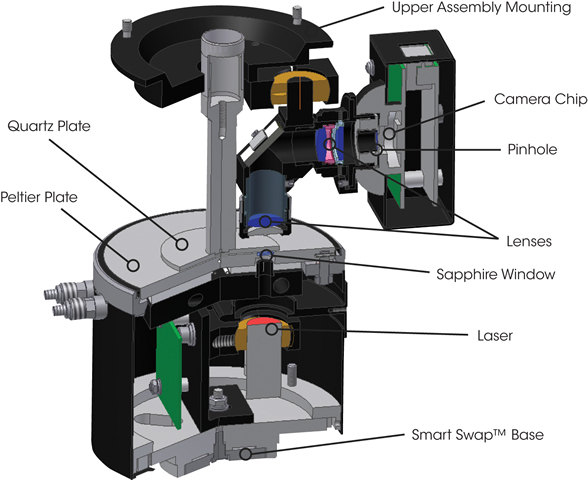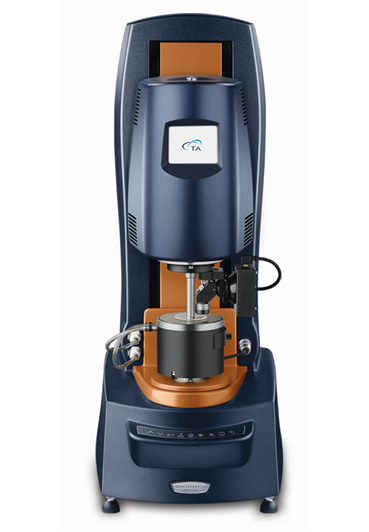Light Scattering

Small Angle Light Scattering (SALS)
The Small Angle Light Scattering (SALS) System is an option for simultaneously obtaining rheological and structural information, such as particle size, shape, orientation and spatial distribution. It is available for the DHR-3 and DHR-2 Rheometers. The option incorporates TA Instruments’ Smart Swap™ technology, bringing a new level of speed and simplicity for making simultaneous rheology and SALS measurements. The system can be installed, aligned, and ready for measurements in as little as five minutes. It features patented Peltier Plate temperature control(1) and the scattering angle (θ) range over which measurements can be made is ~ 6° to 26.8°. The scattering vector range (q) is 1.38 μm-1 to 6.11 μm-1 and the length scale range is about 1.0 μm to ~ 4.6 μm.
Technology

The SALS accessory consists of upper and lower assemblies and quartz plate geometry. The lower assembly includes an integrated Class 2 laser (with 0.95 mW diode and wavelength λ = 635 nm) situated below a patented(1) Peltier Plate with a 5 mm diameter quartz window. The Peltier Plate surface is stainless steel with a temperature range of 5 °C to 95 °C. The upper assembly consists of a set of lenses and a camera. The scattered light is focused through a lens pair mounted within a height-adjustable cap to focus at varying sample depths. The light is then focused through a second lens and sent through an adjustable polarizer for both polarized and depolarized measurements. Finally, the scattering is collected through a pinhole and recorded by the camera. The upper geometry is a 50 mm diameter, 2 mm thick optical quartz disk. To comply with the singlepoint correction for the parallel plates, the laser is set at 0.76 times the plate radius which is 19 mm from the axis of rotation of the plate. This arrangement keeps the SALS system compact, while allowing for quick and reproducible positioning and focusing. A set of neutral density filters is available as an option to reduce laser intensity. (1) U.S. Patent # 7,500,385
 Features and Benefits
Features and Benefits
- Smart Swap™ technology
- q vector range ~1.38 μm-1 to 6.11μm-1
- Objects length scale range ~ 1 μm to 4.6 μm
- Scattering angle ~ 6° to 26.8°
- Wavelength 635 nm
- Compact upper assembly requiring minimal adjustment
- Smart Swap™ lower assembly with factory aligned laser
- Class 2 laser – No safety issues
- Adjustable laser intensity with optional neutral density filters • Variable depth focus to adjust for different geometry gaps
- Adjustable polarizer for scattering in parallel or perpendicular to the incident light
- Image focused directly onto camera chip – Does not require screen or darkened room
- Quantitative measurements possible by calibration with monodisperse Polystryrene beads.
- Optional Analysis Software
- Patented Peltier Plate temperature control
Microscopy
Shear-Induced Phase Separation of Micellar Solutions

Shear-Induced Phase Separation of Micellar Solutions
Self-assembled surfactant micelles show a variety of shear-induced microstructural transformations that are important for material formulation and function for a wide array of applications. Simultaneous measurements of rheology and surfactant microstructure, using SALS under shear, provides a valuable tool in examining shear-induced transitions in such fluids. The data in the figure show scattering images captured synchronously with rheometry data on a surfactant system. At low shear rates below the stress plateau, no measurable scattering is obtained from the sample, suggesting no large-scale structuring of the fluid. However, in the stress plateau, a strong anisotropic scattering pattern develops with increasing shear rate. This “butterfly” pattern results from phase separation, where the interface between the two phases generates a strong scattering contrast.
- Description
-
Small Angle Light Scattering (SALS)
The Small Angle Light Scattering (SALS) System is an option for simultaneously obtaining rheological and structural information, such as particle size, shape, orientation and spatial distribution. It is available for the DHR-3 and DHR-2 Rheometers. The option incorporates TA Instruments’ Smart Swap™ technology, bringing a new level of speed and simplicity for making simultaneous rheology and SALS measurements. The system can be installed, aligned, and ready for measurements in as little as five minutes. It features patented Peltier Plate temperature control(1) and the scattering angle (θ) range over which measurements can be made is ~ 6° to 26.8°. The scattering vector range (q) is 1.38 μm-1 to 6.11 μm-1 and the length scale range is about 1.0 μm to ~ 4.6 μm.
- Technology
-
Technology

The SALS accessory consists of upper and lower assemblies and quartz plate geometry. The lower assembly includes an integrated Class 2 laser (with 0.95 mW diode and wavelength λ = 635 nm) situated below a patented(1) Peltier Plate with a 5 mm diameter quartz window. The Peltier Plate surface is stainless steel with a temperature range of 5 °C to 95 °C. The upper assembly consists of a set of lenses and a camera. The scattered light is focused through a lens pair mounted within a height-adjustable cap to focus at varying sample depths. The light is then focused through a second lens and sent through an adjustable polarizer for both polarized and depolarized measurements. Finally, the scattering is collected through a pinhole and recorded by the camera. The upper geometry is a 50 mm diameter, 2 mm thick optical quartz disk. To comply with the singlepoint correction for the parallel plates, the laser is set at 0.76 times the plate radius which is 19 mm from the axis of rotation of the plate. This arrangement keeps the SALS system compact, while allowing for quick and reproducible positioning and focusing. A set of neutral density filters is available as an option to reduce laser intensity. (1) U.S. Patent # 7,500,385
- Features
-
 Features and Benefits
Features and Benefits- Smart Swap™ technology
- q vector range ~1.38 μm-1 to 6.11μm-1
- Objects length scale range ~ 1 μm to 4.6 μm
- Scattering angle ~ 6° to 26.8°
- Wavelength 635 nm
- Compact upper assembly requiring minimal adjustment
- Smart Swap™ lower assembly with factory aligned laser
- Class 2 laser – No safety issues
- Adjustable laser intensity with optional neutral density filters • Variable depth focus to adjust for different geometry gaps
- Adjustable polarizer for scattering in parallel or perpendicular to the incident light
- Image focused directly onto camera chip – Does not require screen or darkened room
- Quantitative measurements possible by calibration with monodisperse Polystryrene beads.
- Optional Analysis Software
- Patented Peltier Plate temperature control
- Applications
-
Microscopy
Shear-Induced Phase Separation of Micellar Solutions

Shear-Induced Phase Separation of Micellar Solutions
Self-assembled surfactant micelles show a variety of shear-induced microstructural transformations that are important for material formulation and function for a wide array of applications. Simultaneous measurements of rheology and surfactant microstructure, using SALS under shear, provides a valuable tool in examining shear-induced transitions in such fluids. The data in the figure show scattering images captured synchronously with rheometry data on a surfactant system. At low shear rates below the stress plateau, no measurable scattering is obtained from the sample, suggesting no large-scale structuring of the fluid. However, in the stress plateau, a strong anisotropic scattering pattern develops with increasing shear rate. This “butterfly” pattern results from phase separation, where the interface between the two phases generates a strong scattering contrast.







